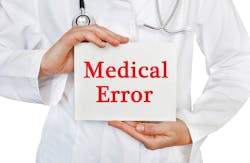The cost of errors and its antithesis, the cost of quality, is often written about in terms of financial impact to medical laboratories and the healthcare system. This article will highlight the human impact of errors, ways in which the errors can occur within the auspices of the laboratory, and the need for more transparency in discussing the challenge in order to reduce the impact.
Medical errors rarely make the headlines and when they do, it’s typically coverage of the most catastrophic events. The public tends to think of these as being attributable to errors by overworked and hurried doctors, such as surgery performed on the wrong side of the body, or a cancer missed on a scan, or simply misinterpreting a patient’s symptoms.
In 2000, the Quality of Healthcare in America project through the Institute of Medicine published a landmark report titled To Err is Human: Building A Safer Health System in which the extent of medical errors was detailed along with recommendations for improvement.1 The report reviewed several studies and estimated that between 44,000 to 98,000 deaths occur in the United States each year due to medical errors, leading to national costs between $17 and $29 billion annually.1 In 2016, the BMJ published a paper detailing a new analysis indicating that medical errors were the third leading cause of death in the United States.2 It further estimated the number of US deaths annually due to medical error at 250,000 minimum, and as high at 400,000. This range equates to 500–1000 deaths every day.2
This data clearly pointed to a national crisis and despite the time between the 2000 and 2016 reports and now, there has been no indication that the trend has been reversed. While the Institute of Medicine categorizes medical errors into four groups: Diagnostic Errors, Treatment Errors, Preventative Errors, and Communication / Equipment or Other Errors.This profession’s natural focus is in Diagnostic Errors.
Diagnostic errors
Consider a few real-life stories.3
- A couple that had been married for 50 years were healthy except he required blood thinner medication for a treatable heart condition. However, incorrect prothrombin test results led to several increases in his medication. He died shortly after of a brain hemorrhage from over-medication.
- Over 100 patients tested positive for prostate cancer when in fact the test results from a prominent institution were wrong and some patients underwent treatment for non-existent tumors. The problem was later determined to be errors by equipment, personnel, and procedures.
- As part of a routine military physical, a soldier was told he was HIV positive. This led to him and his wife separating. Later the soldier found out he was actually HIV negative and the first test had been incorrect.
- A young couple was proud parents of a baby girl until routine tests cast doubt on the father’s paternity. The couple split up over this issue but reunited some years later and had another child. Knowing the first child wasn’t his, he insisted on a paternity test. They subsequently learned the first child was his and the original test had been compromised.
In each of the four cases, something went wrong between tests being ordered and clinicians acting upon results. And in each case, the errors led to traumatic experiences for the individuals and families involved, unintentional death, incorrect treatment, or the demise of a relationship.
A diagnostic error is simply an incorrect diagnosis of a patient condition and typically falls into one of four categories: error or delay in diagnosis, failure to employ indicated tests, use of outmoded tests, or failure to act on results.
In its 2015 report, Improving Diagnosis in Healthcare, the Institute of Medicine estimated that diagnostic error is the cause of 10% of patient deaths, 17% of hospital adverse events, and the leading driver of malpractice claims.4 Perhaps even more surprising was the report’s estimate that, in the US, an individual will be incorrectly diagnosed at least once in their lifetime. This is not just receiving an incorrect diagnosis but that the doctor will also have acted upon it.4
It should be noted that not all diagnostic errors originate in the clinical laboratory. The reported statistics include other types of diagnostics such as imaging, diagnostic errors stemming from misinterpretation of results, and diagnosis and treatment with inadequate information. Unfortunately, very few medical institutions have processes in place, or the resources to track diagnostic errors or determine their causes. Therefore, it’s unknown how many are attributable to laboratory errors.
Laboratories, hospitals, and clinicians alike are naturally reluctant to share information about diagnostic errors due to the litigious nature of society. While almost every laboratory has experienced a laboratory error being acted upon, it is rare that these are shared outside of the institution, even for the sake of educational enlightenment.
US laboratories routinely run upwards of 500 tests, larger laboratories may have another 500 that are run less frequently. This requires each lab to be able to maintain equipment and competency for up to 1,000 tests, and the larger reference labs even twice that, with tests running the gamut of highly automated instrumentation to very manual methods. All of these tests require reliance on equipment and staff performing at the highest level. But instruments fail and human nature being what it is, people make errors as well.
Categories of errors
It’s important that laboratorians, and others who are involved in the testing process, understand potential sources of error so they remain alert and bring attention to a situation that needs to be evaluated before reporting out results. Not all errors are created equally. There are errors that are limited in impact, affecting a single or small number of test results, while other errors have the potential to affect a large number, even across days or weeks of testing. Below are examples of these types of errors
Errors that typically affect multiple patients:
- Lab equipment isn’t working properly. Equipment failures can be small enough to impact sample results without causing an obvious failure. Certain components can begin to react to wear, and will still allow operation but may use an inadequate amount of reagents or cause the calibration to shift.
- Improper storage or handling of reagents. Reagents that are left out or stored at improper temperatures may degrade before their expiration dates and lead to incorrect test results until replaced with reagents that have been handled properly.
- Procedures aren’t followed. A hastily trained employee may not understand a procedure well and apply a shortcut that inadvertently affects all the samples they are running.
- Samples are not properly handled. Samples that are collected offsite may be stored properly until pickup or left for courier pickup and then exceed storage temperatures after leaving the facility.
Errors that typically affect a single patient:
- A sample isn’t collected or labeled properly. The sample may be collected in the wrong tube, it may be poorly drawn and hemolyzed, or not labeled at the time of draw with an incorrect label applied later. In these instances, the impact is to the tests designated to be run on that particular sample tube.
- Samples aren’t properly handled. This can be caused by not rocking the tube to cause mixing with the anti-coagulant. Excessive vibration from transport can cause hemolysis.
- Lab testing with time constraints are delayed in running or reading. Certain tests require samples to be centrifuged or run within a certain amount of time from collection and when not, may lead to incorrect results. Similarly, when a test cartridge that must be read within a specified time period after inoculation is read later than required, may lead to an incorrect result.
- A test result is entered incorrectly into the patient record, or the wrong record. Many but not all instruments automatically communicate with a laboratory information system (LIS) and many test methods require manual entry of results. These can lead to transcription or transposition errors.
Moving forward
Sometimes a single lab test can diagnose a disease but more frequently, several lab tests are used by the clinician to gain insights as to what is happening in the body and aid in the diagnosis. These test results impact the treatment plan a patient receives, such as surgery, medication, or type of therapy. Clinicians use test results as one piece of the puzzle when diagnosing patients, but it’s a critical piece that provides insights that clinical observation cannot uncover.
As the reports point out, errors will always occur but steps can be taken to reduce their number and their impact.
Errors can be prevented by designing systems that make it hard for people to do the wrong thing and easy for people to do the right thing. [It is] a serious concern in healthcare that, if discussed at all, is discussed only behind closed doors. As healthcare and the system that delivers it become more complex, the opportunities for errors abound.1
Communication is key. One of the recommendations of the Institute of Medicine is for health systems and laboratories to create an environment where errors and near misses can be discussed and triaged for improvements. These learnings need to be shared, in a blinded way, outside the individual institutions to benefit not only the greater laboratory community but more importantly, for patients’ well-being. Staff coming forward and sharing errors and near misses during monthly or quarterly quality reviews should also become standard practice. It’s how we all learn.
References:
- Institute of Medicine. Committee on Quality Health Care in America. Kohn KT, Corrigan JM, Donaldson MS, eds. To Err is Human: Building a Safer Health System. Washington, DC: National Academy Press. 2000.
- Makary M A, Daniel M. Medical error—the third leading cause of death in the US. BMJ 2016; 353 :i2139. doi:10.1136/bmj.i2139.
- Gabler, E. Hidden Errors. Milwaukee Journal Sentinel. May 17-Nov 15, 2015 (series). https://archive.jsonline.com/watchdog/watchdogreports/hidden-errors-360092411.html. Accessed March 21, 2022.
- National Academies of Sciences, Engineering, and Medicine. Balogh, E., Miller, B., Ball, J., eds. Improving diagnosis in health care. Washington, DC: The National Academies Press. 2015.
Andy Quintenz serves as Global Scientific and Professional Affairs Manager for Bio-Rad Laboratories’ Quality Systems Division. He works to promote an understanding of laboratory regulations and best practices as they pertain to QC and EQA/PT programs.





